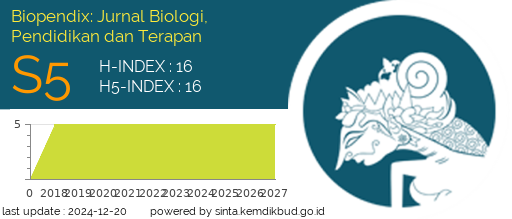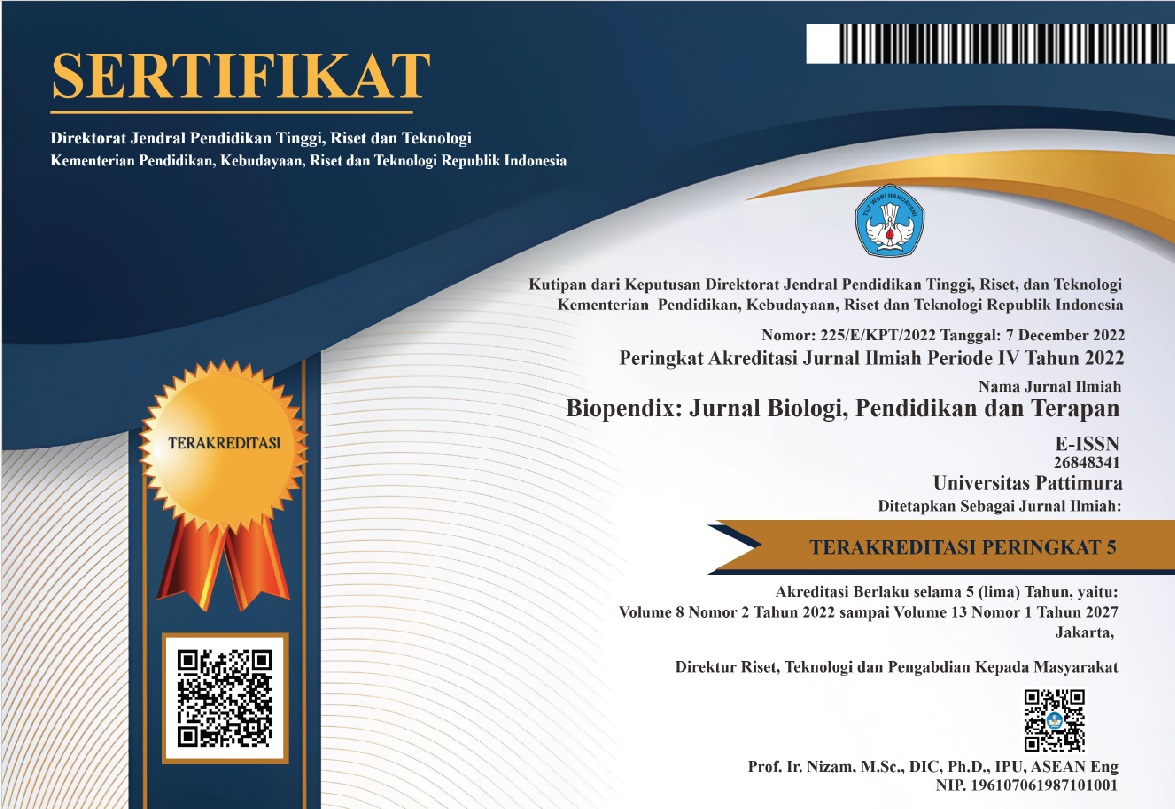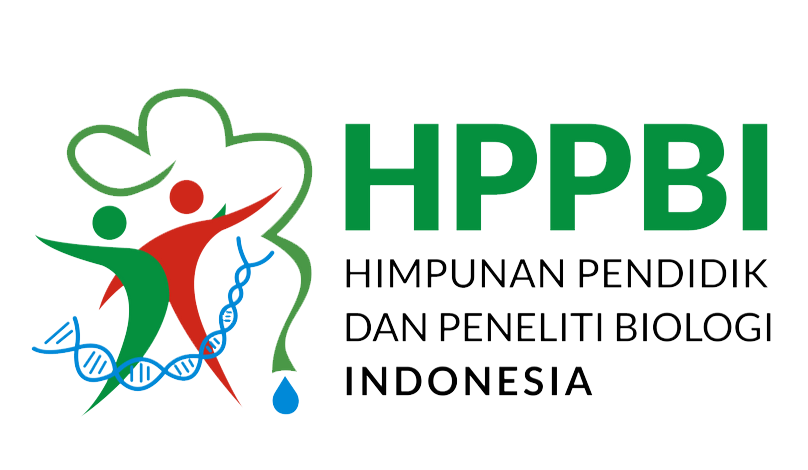ALIGNMENT DAN ANALISIS KEKERABATAN RAYAP COPTOTERMES FORMOSANUS (Isoptera: Rhinotermitidae) PADA HABITAT YANG BERBEDA DENGAN SOFTWARE BIOEDIT DAN MEGA 6 (STUDI PUSTAKA DNA SEKUENSING DARI NCBI)
Abstract
Background: Bioinformatics is a science that can relate information which includes molecular biology, biochemical structure, enzymatic, cell biology, physiology and pathology by using a computerized system based on data that has been collected.
Methods: sequence alignment and phylogenetic tree construction of DNA sequences registered at NCBI in the subterranean termite Coptotermes formosanus Shiraki that lives in different habitats, namely in Mississippi, Southeast Asia, and China using Bioedit and MEGA software.
Results: Sequence alignment showed that termite C. formosanus isolated from MS12 gene COII (FJ870577.1) in the Mississippi area had a base pair of 790 bp, termite C. formosanus isolated from Dinghu Mountain gene COII (KU257993.1) in China has a base pair of 779 bp, and the termite C. formosanus isolated from CF003JP gene COII (EF379943.1) in Southeast Asia has a base pair of 676 bp. The construction of the phylogenetic tree shows that the termite C. formosanus isolated from Dinghu Mountain gene COII (KU257993.1) in the China region has a close kinship with the termite C. formosanus isolated from CF003JP gene COII (EF379943.1) in the Southeast Asia region, while The termite C. formosanus isolated from MS12 gene COII (FJ870577.1) in the Mississippi area is distantly related to C. formosanus (KU257993.1) from China and C. formosanus (EF379943.1) from Southeast Asia.
Conclusion: Mississippi has a base pair of 790 bp, termite C. formosanus isolated from Dinghu Mountain gene COII (KU257993.1), China has a base pair of 779 bp, and termite C. formosanus isolated from CF003JP gene COII (EF379943.1), Southeast Asia has a base pair of 676 bp. China is closely related to the termite C. formosanus isolated from COII gene CF003JP (EF379943.1), Southeast Asia, while the termite C. formosanus isolated from MS12 gene COII (FJ870577.1), Mississippi is distantly related to C. formosanus (KU257993.1) from China and C. formosanus (EF379943.1) from Southeast Asia.
Downloads
References
Blackshields, G., I.M. Wallace, M. Larkin and D.G. Higgins. 2006. Analysis and comparison of benchmarks for multiple sequence alignment. Silico Biol. 6: 321 – 339.
Campora, C.E., and J.K. Grace. 2001. Tunnel orientation and search pattern sequence of the Formosan subterranean termite (Isoptera: Rhinotermitidae). Journal of Economic Entomology. 94: 1193–1199.
Copren, K.A., L.J. Nelson, E.L. Vargo, and M.I. Haverty. 2005. Phylogenetic analyses of mtDNA sequences corroborate taxonomic designations based on cuticular hydrocarbons in subterranean termites. Molecular Phylogenetics and Evolution. 35: 689–700.
Dale JW & Park SF. 2004. Molecular Genetics of Bacteria. 4th.Ed. John Wiley and Sons Inc.pp: 346.
Donovan, S.E., D.T. Jones, W.A. Sands, and P. Eggleton. 2000. Morphological phylogenetics of termites (Isoptera). Biological Journal of the Linnaean Society. 70: 467–513.
Edgar, R.C. and S. Batzoglou. 2006. Multiple sequence alignment. Curr. Opin. Struct. Biol. 6: 368 - 373.
Fisher RA, The Genetical Theory of Natural Selection. Dover Publications. New York, NY (1958).
Gao, D.-R., P.K.S. Lam, and P.T. Owen. 1990. The taxonomy, ecology and management of economically important termites in Chinga. Pest Control Into the 90s: Problems and Challenges (Conference Proceedings). Ed. by P.K.S. Lam and D.K.O’Toole. pp. 23–61.
Haskins J, Quarantine considered to halt spread of Formosan termites. Mississippi Department of Agriculture and Commerce 1(2): 1 and 6 (2001).
Haverty, M.I., R.J. Woodrow, L.J. Nelson, and J.K. Grace. 2005. Identification of termite speciesby the hydrocarbons in their feces. Journal of Chemical Ecology. 31 (9): 2119–
Husseneder C and Grace JK, Evaluation of DNA fingerprinting, aggression tests and morphometry as tools for colony delineation of the Formosan subterranean termite. J Ins Behavior 14:173–186 (2001).
H. Sinay. PPT Perkuliahan Ke-VII (DNA Sequencing). 2017.
Jenkins, T.M., R.E. Dean, R. Verkerk, and
B.T. Forschler. 2001. Phylogenetic analyses of two mitochondrial genes and one nuclear intron region illuminate European subterranean termite (Isoptera: Rhinotermitidae) gene flow, taxonomy, and introduction dynamics. Molecular Phylogenetics and Evolution. 20 (2):286–293.
Kambhampati, S., and P. Eggleton. 2000. Taxonomy and phylogeny of termites. Termites: Evolution, Sociality, Symbioses, Ecology. Ed. By T. Abe, D. E. Bignell, and M. Higashi. pp. 1–23.
Kemena, C. and C. Notredame. 2009. Upcoming challenges for multiple sequence alignment methods in the highthroughput era. Bioinformatics. 25: 2455 – 2465.
Kistner, D.H. 1985. A new genus and species of termitophilous Aleocharinae from mainland China associated with Coptotermes formosanus and its zoogeographic significance (Coleoptera: Staphilinidae). Sociobiology. 10 (1): 93–104.
Mcdonald, J.H and M. Kreitman. 1991. Adaptive protein evolution at the Adh locus in Drosophila. Nature. 351: 652 - 654.
Mount, D.W. 2001. Phylogenetic prediction. In: Bioinformatic, Sequence and Genome Analysis. Cold Spring Harbor laboratory. New York Press pp. 237 - 280.
Nielsen, R. and Z. Yang. 1998. Likehood models for detecting positively selected amino acid sites and application to the HIV-1 envelope gene. Genetics. 148: 929 - 936.
Notredame, C. 2007. Recent evolutions of multiple sequence alignment algorithms. PLOS Comput. Biol. 3: E123.
Ohkuma, M., H. Yuzawa, W. Amornsak, Y. Sornnuwat, Y. Takematsu, A. Yamada, C. Vongkaluang, O. Sarnthoy, N. Kirtibutr, N. Noparatnaraporn, T. Kudo, and T. Inoue. 2004. Molecular phylogeny of Asian termites (Isoptera) of the families Termitidae and Rhinotermitidae based on mitochondrial COII sequences. Molecular Phylogenetics and Evolution. 31: 701–710.
Page, M., L.G. Melson, B.T. Forschler, and
M.I. Haverty. 2002. Cuticular hydrocarbons suggest three lineages in Reticulitermes (Isoptera: Rhinotermitidae) from North America. Comparative Biochemistry and Physiology Part B. 131: 205–324.
Pruess KP, Adams BJ, Parsons TJ, Zhu X and Powers TO, Utility of the mitochondrial cytochrome oxidase II gene for resolving relationships among black flies (Diptera: Simuliidae). Mol Phylogen Evolut 16:286–295 (2000).
Ross, K.G. 2001. Molecular ecology of social behaviour: analyses of breeding systems and genetic structure. Molecular Ecology. 10: 265–284.
Saitou, N. and T. Imanishi. 1989. Relative efficiencies of the Fitch-Margoliash,Maximum-Parsimony, Maximum- Likehood, Minimum Evolution amd Neighbor-joining Methods of phylogenetic tree construction in obtaining the correct tree. Mol. Biol. Evol. 6(5): 514 - 525.
Schmidt H. 2003. Phylogenetic Trees From Large Datasets. Inaugural- Dissertation,DusseldorfUniversity.Htt p://Www.Bi.Uniduesseldorf.De/~Hsc hmidt/Publ/Schmidt203.phdthesis.pd f.(23 Januari 2011).
Su, N.-Y. 2002. Novel technologies for subterranean termite control. Sociobiology 40: 95Ð101.
Thompson, G.J., L.R. Miller, M. Lenz, and R.H. Crozier. 2000. Phylogenetic analysis and trait evolution in Australian lineages of drywood termites (Isoptera, Kalotermitidae). Molecular Phylogenetics and Evolution. 17 (3): 419–429.
Vargo, E.L., C. Husseneder, and J.K. Grace. 2003. Colony and population genetic structure of the Formosan subterranean termite, Coptotermes formosanus, in Japan. Molecular Ecology. 12: 2599–2608.
Woodson WD, Wiltz BA and Lax AR, Current distribution of the Formosan subterranean termite (Isoptera: Rhinotermitidae) in the United States. Sociobiology 37:661–671 (2001).
Wang, JS, and J.K. Grace. 1999. Current status of Coptotermes Wasmann (Isoptera: Rhinotermitidae) in China, Japan, Australia and the American Pacific. Sociobiology 33: 295–305.
Ye, W., C.-Y. Lee, R. H. Scheffrahn, J.M. Aleong, N.-Y. Su, G.W. Bennett, and M.E. Scharf. 2004. Phylogenetic relationships of nearartic Reticulitermes species (Isoptera: Rhinotermitidae) with particular reference to Reticulitermes arenincola Goellner. 2004. Molecular Phylogenetics and Evolution. 30: 815–822

Authors who publish with this Journal agree to the following terms:
- Author retain copyright and grant the journal right of first publication with the work simultaneously licensed under a creative commons attribution license that allow others to share the work within an acknowledgement of the work’s authorship and initial publication of this journal.
- Authors are able to enter into separate, additional contractual arrangement for the non-exclusive distribution of the journal’s published version of the work (e.g. acknowledgement of its initial publication in this journal).
- Authors are permitted and encouraged to post their work online (e.g. in institutional repositories or on their websites) prior to and during the submission process, as it can lead to productive exchanges, as well as earlier and greater citation of published works




 2
2






